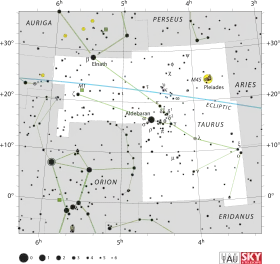Phi Tauri
Phi Tauri (φ Tauri) is a solitary,[7] orange-hued star in the zodiac constellation of Taurus. It has an apparent visual magnitude of +4.96,[2] which indicates the star is faintly visible to the naked eye. Based upon an annual parallax shift of 10.16 mas as seen from Earth,[1] it is located roughly 321 light years distant from the Sun. At that distance, the visual magnitude of the star is diminished by an extinction factor of 0.27 due to interstellar dust.[8]
 | |
| Observation data Epoch J2000.0 Equinox J2000.0 (ICRS) | |
|---|---|
| Constellation | Taurus |
| Right ascension | 04h 20m 21.21580s[1] |
| Declination | +27° 21′ 02.7009″[1] |
| Apparent magnitude (V) | +4.957[2] |
| Characteristics | |
| Spectral type | K1 III[2] |
| B−V color index | 1.154[2] |
| Astrometry | |
| Radial velocity (Rv) | 1.27[2] km/s |
| Proper motion (μ) | RA: −28.90[1] mas/yr Dec.: −78.28[1] mas/yr |
| Parallax (π) | 10.16 ± 0.26[1] mas |
| Distance | 321 ± 8 ly (98 ± 3 pc) |
| Absolute magnitude (MV) | −0.15[3] |
| Details[4] | |
| Mass | 1.36±0.19 M☉ |
| Radius | 19.04±0.56 R☉ |
| Luminosity | 131.0±6.8 L☉ |
| Surface gravity (log g) | 2.02±0.08 cgs |
| Temperature | 4,479±30 K |
| Metallicity [Fe/H] | −0.32±0.10 dex |
| Rotational velocity (v sin i) | 1.0[5] km/s |
| Age | 4.74±2.56 Gyr |
| Other designations | |
| Database references | |
| SIMBAD | data |
This is an evolved, K-type giant star with a stellar classification of K1 III,[2] currently (97% probability) on the red giant branch. It has an estimated 1.36 times the mass of the Sun and has expanded to 19 times the Sun's radius. At the age of roughly five billion years, it is radiating 131 times the Sun's luminosity from its inflated photosphere at an effective temperature of 4,479 K.[4]
Phi Tauri has a magnitude 7.51 visual companion located at an angular separation of 48.80 arc seconds along a position angle of 258°, as of 2015. The pair form a yellow and blue double that is visible in small telescopes.[9] A fainter, magnitude 12.27 companion lies at a separation of 118.10 arc seconds along a position angle of 25°, as of 2001.[10]
Naming
- With κ1, κ2, υ and χ, it composed the Arabic were the Arabs' Al Kalbain, the Two Dogs.[11] According to the catalogue of stars in the Technical Memorandum 33-507 - A Reduced Star Catalog Containing 537 Named Stars, Al Kalbain were the title for five stars : this star (φ) as Alkalbain I, χ as Alkalbain II, κ1 as Alkalbain III, κ2 as Alkalbain IV and υ as Alkalbain V.[12]
- In Chinese, 礪石 (Lì Dàn), meaning Whetstone, refers to an asterism consisting of φ Tauri, ψ Tauri, 44 Tauri and χ Tauri. Consequently, the Chinese name for φ Tauri itself is 礪石四 (Lì Dàn sì, English: the Fourth Star of Whetstone.).[13]
References
- van Leeuwen, F. (2007), "Validation of the new Hipparcos reduction", Astronomy and Astrophysics, 474 (2): 653–664, arXiv:0708.1752, Bibcode:2007A&A...474..653V, doi:10.1051/0004-6361:20078357.
- Luck, R. Earle (September 2015), "Abundances in the Local Region. I. G and K Giants", The Astronomical Journal, 150 (3): 23, arXiv:1507.01466, Bibcode:2015AJ....150...88L, doi:10.1088/0004-6256/150/3/88, 88.
- Luck, R. Earle; Heiter, Ulrike (June 2007), "Giants in the Local Region", The Astronomical Journal, 133 (6): 2464–2486, Bibcode:2007AJ....133.2464L, doi:10.1086/513194.
- Reffert, Sabine; et al. (2015), "Precise radial velocities of giant stars. VII. Occurrence rate of giant extrasolar planets as a function of mass and metallicity", Astronomy & Astrophysics, 574: A116, arXiv:1412.4634, Bibcode:2015A&A...574A.116R, doi:10.1051/0004-6361/201322360, hdl:10722/215277.
- De Medeiros, J. R.; et al. (November 2000), "Rotation and lithium in single giant stars", Astronomy and Astrophysics, 363: 239–243, arXiv:astro-ph/0010273, Bibcode:2000A&A...363..239D.
- "phi Tau". SIMBAD. Centre de données astronomiques de Strasbourg. Retrieved 2017-08-05.
- Eggleton, P. P.; Tokovinin, A. A. (September 2008), "A catalogue of multiplicity among bright stellar systems", Monthly Notices of the Royal Astronomical Society, 389 (2): 869–879, arXiv:0806.2878, Bibcode:2008MNRAS.389..869E, doi:10.1111/j.1365-2966.2008.13596.x.
- Famaey, B.; et al. (January 2005), "Local kinematics of K and M giants from CORAVEL/Hipparcos/Tycho-2 data. Revisiting the concept of superclusters", Astronomy and Astrophysics, 430 (1): 165–186, arXiv:astro-ph/0409579, Bibcode:2005A&A...430..165F, doi:10.1051/0004-6361:20041272.
- Privett, Grant; Jones, Kevin (2013), The Constellation Observing Atlas, The Patrick Moore Practical Astronomy Series, Springer Science & Business Media, p. 187, ISBN 1461476488.
- Mason, B. D.; et al. (2014), The Washington Visual Double Star Catalog, Bibcode:2001AJ....122.3466M, doi:10.1086/323920, retrieved 2015-07-22
- Allen, Richard Hinckley (1899), Star-Names and Their Meanings, New York: G. E. Stechert, p. 413
- Rhoads, Jack W. (November 15, 1971), Technical Memorandum 33-507-A Reduced Star Catalog Containing 537 Named Stars (PDF), Jet Propulsion Laboratory, California Institute of Technology.
- (in Chinese) AEEA (Activities of Exhibition and Education in Astronomy) 天文教育資訊網 2006 年 5 月 22 日
